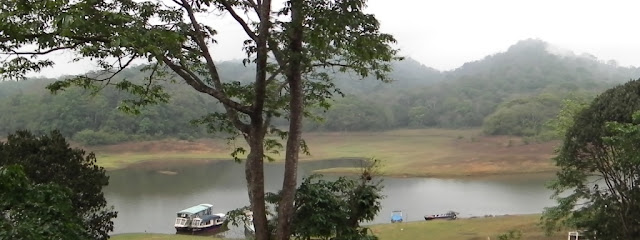Periyar lake is located within the Periyar National Park, or Periyar Tiger Reserve, as it is commonly called. The lake was artificially created by building the Mullaperiyar dam across Periyar river, in what was originally a river valley covered with forests.
Tree stumps of the submerged forest can be seen even today, although most have been cleared to create a waterway for the tourist boats. During the summer, the lake is more of river, snaking through the valley surrounded by thick evergreen forests.
The boat rides are good and provide a safe way watching wildlife. However, ticket sales can be better managed. Tickets are sold on first-come basis. This creates a lot of confusion, as there is rush towards the counters, where one has to fill a form with your name and age, before the tickets can be bought. Also, the best seats for viewing wildlife are on the upper deck of the boat, but you are not permitted to select seats and may be allotted seats on the lower deck if you are unlucky.
Both, the Kerala Tourism Development Corporation (KTDC) and Kerala Forest Department (KFD) operate boat services for tourists. The KTDC boats are better maintained and faster than KFD boats – a good 10 minutes faster. But, you would be better off seated on the KFD boat. That’s because the KTDC boats have rows of 4 seats and are not suitable for those stuck in the middle, while KFD boats only have 2 seats in each row.
The faster speed also negates the very purpose of the ride – watching and photographing wildlife. On the day of our visit, a herd of elephants emerged from the forest towards the end of the ride, a sight the KTDC tourists missed, as they had already disembarked and exited from the area. Suggestion: the KTDC counter is on the left and KFD counter is on the right.
The best time to take the boat ride is in the morning at 0730. At this time, it is not too hot and the weather is pleasant. It is also the time when one can spot several wild animals as they emerge to quench their thirst. We were lucky and could spot several birds, sambar (deer), wild boar, bison (Indian Gaur) and elephants.
Snake-bird or Darter
Indian Cormorant
A general observation
One is sure to notice that the forest reserves are well maintained. This is because the ban on use of plastics is strictly enforced by the Forest Department. May be we should hand over civic administration duties in the cities to the foresters.
Keep our surroundings clean; reduce use of plastic - save the environment from further deterioration.
















